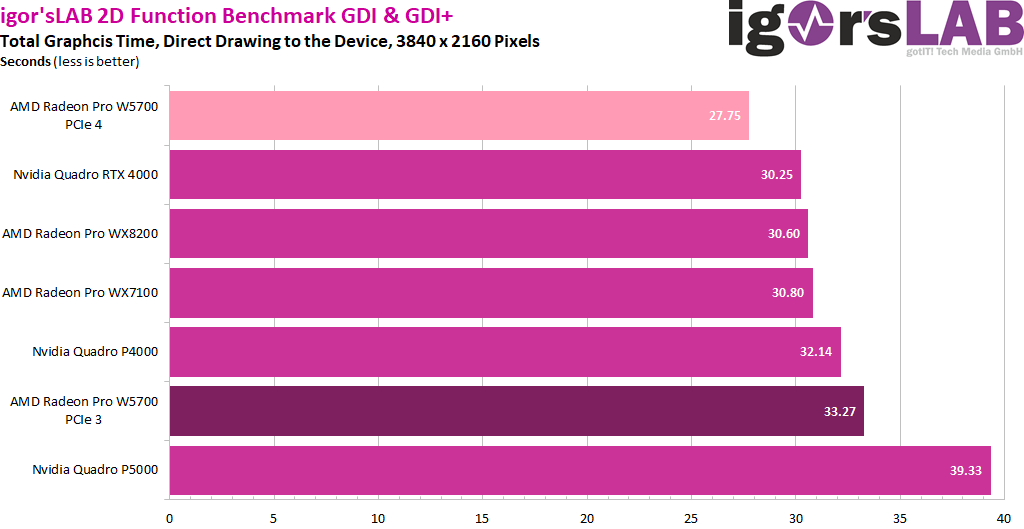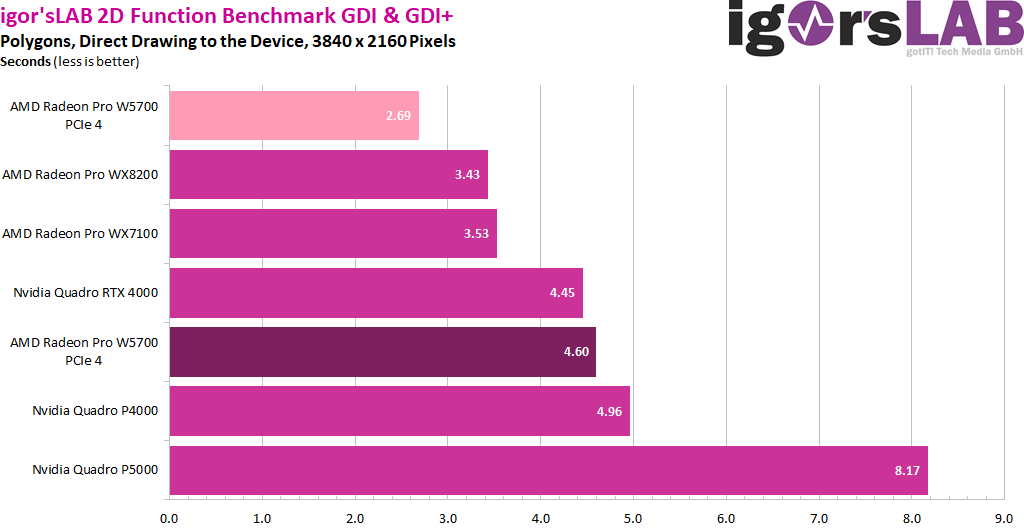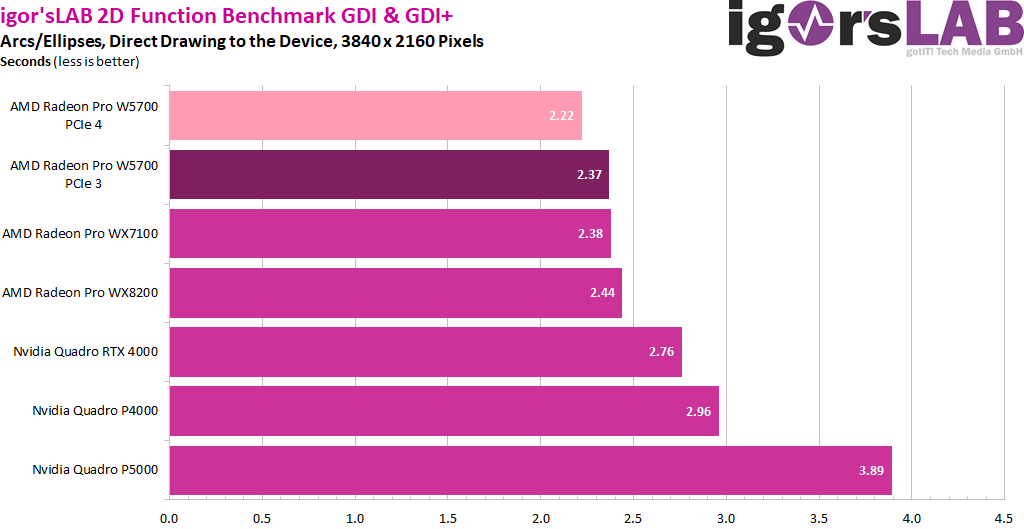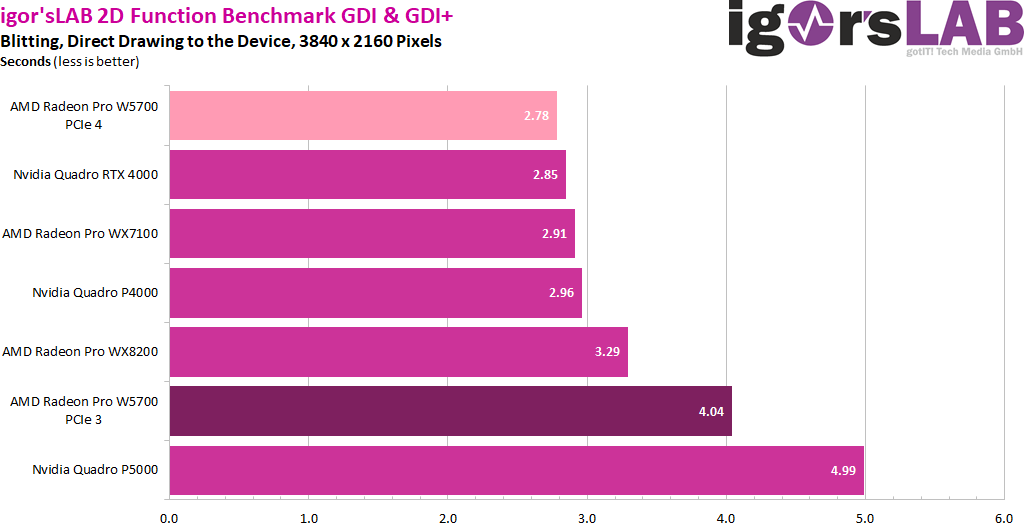First I test the Graphics Device Interface (GDI/GDI+) of Windows with my own benchmark, which was already used in my investigations in 2009 of the 2D weakness of ATI graphics cards in older versions. The AMD driver team in Toronto has meanwhile, after they didn’t want to believe me at the beginning, caught up a lot and eliminated the disadvantages step by step. Whether it’s older graphics applications up to CAD programs or just displaying the simple GUI of many programs – there is still a lot of output via the GDI
This is because all Windows versions after XP no longer support hardware-accelerated output for the 2D graphics functions, especially since the introduction of the Unified Shaders and the elimination of the specialized 2D units on the graphics cards, all of these things have to run via the driver as a kind of wrapper. The CPU has to do most of the computing, and in the end it’s also up to the driver how efficient and with which overhead the output to the D3D is done. The driver models since Vista still support, at least in parts, the hardware acceleration for blitting, i.e. copying graphics content within the memory.
Since I have the possibility to write directly to the device with this test, one can of course also use the PCIe interface to its full capacity, which is beautifully proven by the entire render time. If the Radeon Pro W5700 with PCIe 4.0 was the fastest card in the launch article, it definitely has to lag behind with 3.0, because the time needed increases by almost 20%!
However, the really large time difference results only from a few partial benchmarks. Things like text, rectangles, lines or splines are very simple and cause relatively little traffic. Therefore I left them out at this point. But it gets interesting with the 2D polygons with random color fill and outline design. In the D3D implementation, a lot of single data is produced here, because I use separate styles for each object. This results in an increase of a whopping 71%!
For the ellipses and circles, the difference is not quite as pronounced, but it is still just under 7%.
Blowing a lot of textures onto the device also causes a lot of data traffic, especially in the tested Ultra-HD resolution. A good 45% more time with PCIe 3.0 is really a big number.
The stretching is similar, but the difference is almost halved to about 21%, which is also due to the extra work of the CPU, which slows down a bit here.
We see that synthetic benchmarks or elaborate user interfaces, which still rely on MFC, for example, can definitely show a bandwidth limit. Even Corel Draw feels much faster and smoother in older versions on the PCIe 4.0 system, especially when panning and zooming large drawings. But there are also everyday situations in which the system clearly benefits from PCIe 4.0. Please turn the page once!
AMD Radeon PRO W5700, 8GB GDDR6, 5x mDP, USB-C (100-506085)
 | Zentrallager: verfügbar, Lieferung 3-5 WerktageFiliale Wilhelmshaven: nicht lagerndStand: 19.04.24 09:28 | 231,43 €*Stand: 19.04.24 09:31 |
 | Sofort lieferbar | 231,44 €*Stand: 19.04.24 09:29 |
 | Lieferbar in 2-4 Tagen, Lieferzeit gesamt 4-9 Werktage | 237,00 €*Stand: 19.04.24 08:47 |
AMD Ryzen 9 3950X, 16C/32T, 3.50-4.70GHz, boxed ohne Kühler (100-100000051WOF / 100-100000051BOX)
AMD Ryzen 9 3900X, 12C/24T, 3.80-4.60GHz, boxed (100-100000023BOX)
 | Lieferzeit 4-6 Werktage | 498,97 €*Stand: 19.04.24 08:49 |




































Kommentieren